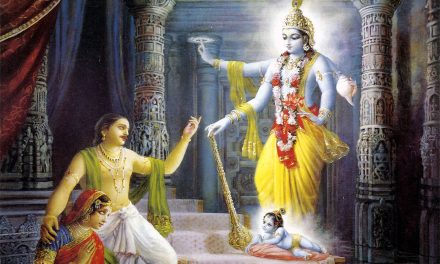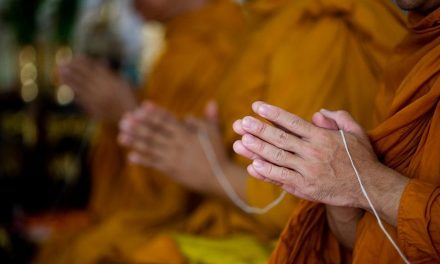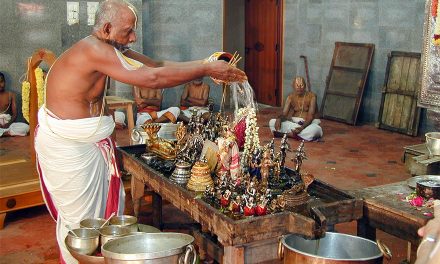The Banglapedia is an online version of the National Encyclopedia of Bangladesh. In it, we find an interesting summary of literature written about the pastimes of Sri Caitanya Mahaprabhu. While Gaudiya Vaisnavas will certainly take exception to some aspects of the summary, and particularly the absence of certain key facts and authors, we present it for the consideration of the devotees. Like today’s popular Wikipedias, readers can encourage the Banglapedia editors to revise the content, advocating for a more accurate representation of Lord Caitanya’s literary legacy.
Chaitanya Literature
“The Bangla and Sanskrit literature devoted to the charismatic religious figure Krishna Chaitanya, ne Vishvambhara Mishra (1486-1533), constitutes the largest subset of Vaisnava sectarian literature in the Bangla-speaking region. The literature has taken three highly distinct forms starting in the 16th century: hagiographical writings in Bangla, Sanskrit, and Oriya; padas celebrating his devotion, primarily in Bangla and Brajabuli, and some Sanskrit; and from these sources derivative retellings of his life primarily in Bangla and English prose, but also in other vernaculars. The latter emerged in the 19th century with the widespread use of the printing press. In the last century occasional fictional versions of his life have been published in the forms of novels, dramas, and poetry.
The earliest forms of this literature serve as the primary sources for historical reconstruction of Chaitanya’s life; but like hagiography in any religious tradition, the portrayal is a special idealized form that is shaped as much by sectarian belief as it is by accurate depictions of what took place. The role of this literature is much greater in its inspirational function to provide a model for devotees to emulate, learning Vaisnavism through the telling of Chaitanya’s personal actions, and in this hagiography remains central to Gaudiya Vaisnava religious experience.
The 16th century hagiographies are the best known works devoted to Chaitanya, starting with Murari Gupta’s Sanskrit Krishna Chaitanyacharitamrita, completed shortly after Chaitanya’s passing. Murari wrote with the authority of one who was senior companion to Chaitanya in Navadvipa. His narrative, often called a Kadacha, ‘notebook’ or ‘diary’, established the standard chronology for events in Chaitanya’s life that has been followed by all subsequent authors, and he was the first hagiographer to articulate a vision of Chaitanya as divine. Within little more than a decade of Murari’s text, Chaitanya’s prominent companion Nityananda deputed his young devotee Vrindavana Dasa to write the Chaitanya Bhagavata in Bangla. Arguably the most popular hagiography and one that tells of Chaitanya’s years in Nadia, the 25,000 line Chaitanya Bhagavata captured the efflorescence of devotional fervor in a prose style that was earthy and electrifying, so much so that its author has been dubbed the Vyasa of the Chaitanya-lila. His portrayals of kirtana in the courtyard of Shrivasa were the primary vehicles for describing Chaitanya’s newly recognised divinity wherein he was identified with Krishna as svayang bhagavan and at the same time the yugavatara, the incarnation of the age.
Some sixty or so years after the completion of Vrindavana Dasa’s monumental book, Krishnadasa Kaviraja composed the most sophisticated hagiography of the set, titled Chaitanya Charitamrita (c 1600-1612). As the title suggests this text focuses not just on the acts (charita), but on the meaning (amrita) of the acts, and in so doing becomes the final word in matters theological as they relate to Chaitanya. A 24,000 line compendium of Vaisnava ritual instruction, theology, aesthetics, and devotionalism, the Chaitanya Charitamrita paired itself to the Chaitanya Bhagavata and effectively closed the creative period of hagiography by providing a key by which devotees could read and rectify discrepancies in all the prior interpretations of Chaitanya’s life. In this text Chaitanya is understood to be the dual androgynous descent of Radha and Krishna, forever fused in a single form, the position that continues to dominate Gaudiya Vaisnava theology today.
In the intervening decades between the Chaitanya Bhagavata and the Chaitanya Charitamrita, a number of other less well-circulated hagiographical works were composed, among the most prominent, Kavikarnapura’s Sanskrit poem Krishna- Chaitanyacharitamritam Mahakavyam (c 1542) and the much later dramatic work Chaitanyachandrodaya Natakam (c 1572-79), Lochana Dasa’s Bangla Chaitanya Mangala (c 1570-80), and the popular but controversial Bangla tale by Jayananda also titled Chaitanya Mangala (c 1550-60).
During the last half of the 16th and early 17th century writers associated with the Oriya religious community surrounding the ‘five companions’ (pancha sakha) composed several sizeable hagiographies of local religious figures based on their association with Chaitanya. They tended to interpret Chaitanya’s divinity in a distinctively Oriya manner as a manifestation of Jagannatha in the void of ‘shunyata’. Among the most well-known are the heavily theological Shunya Sanghita of Achyutananda (c late 1560s), followed by Divakara Dasa’s Jagannatha Charitamrita (c 1580s?), Ishvara Dasa’s Chaitanya Bhagavata (c 1650-60), all of which are anathema to Gaudiya Vaisnava devotees. There are numerous shorter, lesser, and loss works in Bangla and Oriya.
Although they cannot be dated with precision, it is clear that the earliest form of Chaitanya literature was the pada or lyric verse form, primarily sung in public and private kirtana gatherings. These padavali were composed by some of Chaitanya’s closest companions in Navadvipa, such as Narahari Sarkar, Shivananda Sen, Mukunda Dasa and his son Raghunandana, and Vasudeva Ghosa, and his brother Madhava. In the next generation it was their students, such as Lochana Dasa, who continued the tradition. Vishvanatha Cakravarti first anthologized these poems in Ksanada-gitachintamani in the late 17th century. Some of the poems depict the baby Vishvambhara like the baby Krishna, but the more common theme is the youthful exuberance of his coming of age. Just as Krishna is depicted playing with the cowherd girls of Vrindavana, Gaura or Gauranga, the Golden Limbed One, is depicted with the women of Nadia. This depiction – called generally the Gaura-nagara-bhava – understandably troubles the more conservative elements of the community, and even more so the graphically intimate subset called Nadia-nagari-bhava that connected Chaitanya intimately to members of the devotional community, both attitudes that were denounced by Vrindavana Dasa in the Chaitanya Bhagavata (1.10.197, 208-11). In spite of the censure of a small number of the poems, they provide riveting vignettes of the idealized emotional content of devotional life during these crucial years of Chaitanya’s residence in Navadvipa.
Sanskrit works in this genre were also composed in the 16th century, the longest and most highly touted being the Chaitanyachandramritam of Gosvami-student Prabodhananda Sarasvati, a eulogy of 143 shlokas in 12 cantos. Other devotional works include numerous astaka and stotra compositions that glorify but provide little historical information about Chaitanya; so too the ganoddesha genre, which identifies Chaitanya and his companions with their counterparts in Krishna’s realm. Sahajiya authors appropriated the figure of Chaitanya for their own special tantrika view. With the exception of Akinchana Dasa’s early 17th century Vivarta Vilasa, which is by its own admission a running commentary on the Chaitanya Charitamrita, there is little historical perspective; Chaitanya’s presence primarily used to justify their rituals and theology.
It was not until the 19th century that new types of hagiographical literature began to emerge – mainly prose versions of his life, many of which were illustrated – a literature in response to the demands of a newly educated urban elite and easily circulated, thanks to the ready availability of the printing press. The genre was dramatically transformed by Shishir Kumar Ghosa’s Amiya Nimai Charita, a dramatic synthesis of history and devotion that personalises his understanding of the life of Chaitanya in six volumes of mixed prose and textual quotation. Since the publication of the last volume of this serial production in 1910, the text has seen more than 20 editions and printings. Of the hundreds of studies and retellings of the life of Chaitanya by the academic community within the Gaudiya tradition, two monumental works extended that mixture of devotion and rigorous scholarship to new standards of research and scholarship. Vrindavana-based devotee Haridasa Gosvami completed a monumental two-volume work titled Shrimanmahaprabhur Navadvipa Lila (vol.1, c 1915) and Nilachala Lila (vol. 2, c 1926) that covers more than 1784 pages.
Several decades later, but continuing the scholastic tradition, Radhagovinda Natha published Mahaprabhu Shrigauranga (c 1963) compiling hagiographical detail in nearly 1300 pages of text. The life of Chaitanya has inspired plays, such as Dilip Kumar Roy’s 1950 production of Sri Chaitanya: A Drama in Three Acts, poems, paintings, and novels. In both handwritten manuscript and printed form, the literature devoted to Chaitanya continues to thrive as one of the largest genres in the Bangla-speaking world.”













